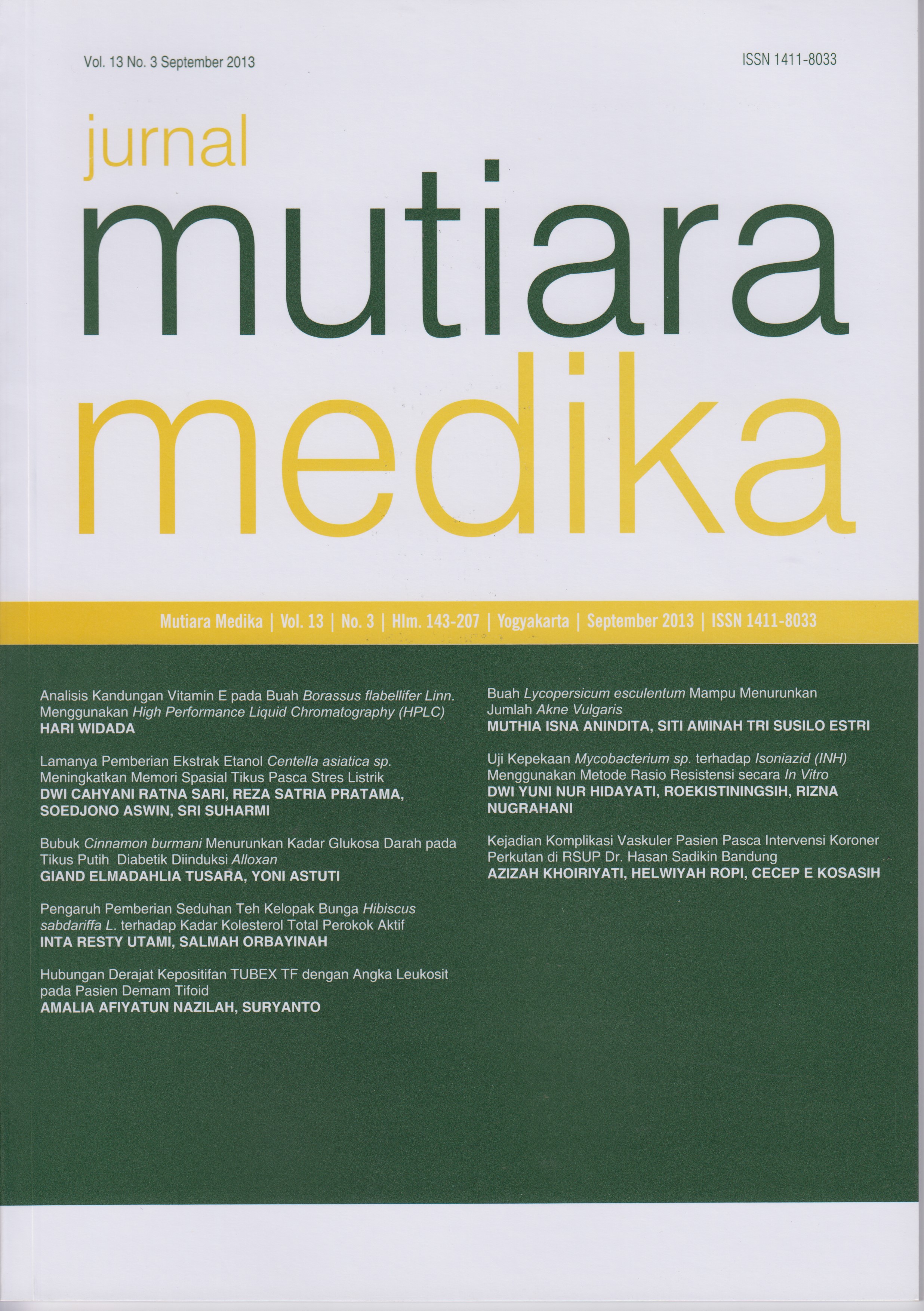Bubuk Cinnamon burmani Menurunkan Kadar Glukosa Darah pada Tikus Putih Diabetik Diinduksi Alloxan
DOI:
https://doi.org/10.18196/mmjkk.v13i3.2480Keywords:
Cinnamon burmani, gula darah, flavonoid, Diabetes Mellitus, blood glucoseAbstract
Bubuk kayu manis mengandung flavonoid yang memiliki efek hipoglikemik untuk menurunkan kadar gula darah. Tujuan penelitian ini adalah untuk mengetahui efek pemberian bubuk kayu manis (Cinnamon burmani) terhadap kadar gula darah pada tikus diabetes diinduksi alloxan. Penelitian ini adalah penelitian eksperimental laboratorium dengan rancangan penelitian pre and post tets control design menggunakan 18 tikus yang dibagi menjadi 3 kelompok, masing-masing terdiri 6 ekor tikus. Kelompok pertama tidak diberikan perlakuan, kelompok kedua diberi bubuk C. burmani3,6 mg/hari dan kelompok ketiga diberi bubuk C. burmani7,2 mg/hari. Tikus di kelompok 2 dan 3 diberi bubuk C. burmani setiap hari selama 21 hari. Data yang diperoleh dianalisis menggunakan ANOVA satu jalan dilanjutkan dengan uji post-hoc Tukey HSD. Hasil uji menunjukkan bahwa pemberian bubuk C. burmani memberikan efek penurunan gula darah berrmakna (p< 0.05). Dosis terbaik untuk menurunkan kadar gula darah dalam penelitian ini adalah 7,2 mg/day setelah pemberian selama 21 hari. Pemberian dosis 2 kali lipat tidak menyebabkan kecepatan penurunan gula darah 2 kali lipat juga. Disimpulkan bahwa pemberian bubuk C. burmani dapat menurunkan kadar glukosa darah pada tikus putih diabetik yang diinduksi alloxan.
Cinnamon powder contain flavonoid as antioxidant and MHCP (methylhydroxy-chalcone polymer) which provide hypoglycemic effect to reduce level blood glucose. The aim of this study is to know the effect of cinnamon powder (Cinnamon burmani) given to the blood glucose in alloxan-induced diabetic rats. This research was an experimental laboratory with pre and post tets control design using 18 rats were divided into three groups, each group were 6 rats. The first group were not given anything, the second group were given cinnamon powder 3,6 mg/day and the third were given cinnamon powder 7,2 mg/day. Rats in group 2 and 3 were given cinnamon powder everyday for 21 days. Hypoglycemic activity was evaluated at day 0, 7, 14 and 21. The data was compared statistically using one-way analysis of variance (ANOVA) followed by post-hoc test Tukey HSD. The result indicated that cinnamon powder giving significant effect on the reduction of blood glucose. In this research were used the optimum doses to decreasing blood glucose level at 7,2 mg/day after 21 days treatment The double doses cannot also decreasing speed of blood glucose causes. It was concluded that C. Burmani powder can decrease blood glucose levels in diabetic mice induced alloxan.
References
Rukmana, R. Temulawak-Tanaman Rempah dan Obat. Yogyakarta : Kanisius. 1995.
Republika. Kayu Manis ManjurRedakan Nyeri. 2009. diakses dari http://www.republika.co.id/ berita/33276/Kayu_Manis_Manjur_Redakan_ Nyeri pada tanggal 20 April 2009
Freakazoid. Kayu Manis, si harum yang baik untuk kesehatan. 2008. Diakses tanggal 20 April 2009 dari http://www.sinarharapan.co.id/ berita/0606/30/ipt04.html
Taher, M., Majid, F.A.A. & Sarmidi, M.J. A Proanthocyanidin from Cinnamomum Zeylani- cum Stimulates Phosphorylation of Insulin Re-ceptor in 3T3-L1 Adipocytes. Jurnal Teknologi Universiti Teknologi Malaysia. 2006. 53-68.
Pham AQ, Kourlas H, Pham DQ. Cinnamon Supplementation in Patients with Type 2 Dia-betes Mellitus. Pharmacotherapy, 2007; 27 (4): 595 - 599.
Azima, F Kayu Manis Tangkal Kanker Hati Ganas. 2004. Diakses Tanggal 2 Desember 2009 dari http://kesehatan.kompas.com.
Kannappan, S., Jayaraman, T., Rajasekar, P., Ravichandran, M.K., Anuradha, C.V. Cinna-mon Bark Extract Improves Glucose Metabo-lism and Lipid Profile in the Fructose-Fed Rat. Singapore Med Journal, 2006; 47(10):858- 863.
Khan, A., Safdar, M., Khan, Mohammad, M.K., Khattak, K.N., Anderson, R. Cinnamon Im-proves Glucose and Lipids of People With Type 2 Diabetes. Diabetes Care, 2003; 26 : 3215¬3218.
Barham, D. and Trinder, P. An Improved Colour Reagen for Determination of Blood Glucose by the Oxydase System. Analist, 1972; 97 (151): 142 - 145.
Okamoto, H. Okamoto Model For 2_CeH Dam-age. Recent Advances Lesson From Animal Diabetes VI. 75th Anniversary of The Insulin Discovery. Birkhauzer, Berlin: Elcazar Shafir. 1996.
Palmer H,J. and K.E. Paulson. Reactive oxy-gen species and antioxidants in signal trans-duction and gene expression. Nutritional Re-view, 1997; 55 (10): 353 - 361.
Downloads
Issue
Section
License
Copyright
Authors retain copyright and grant Mutiara Medika: Jurnal Kedokteran dan Kesehatan (MMJKK) the right of first publication with the work simultaneously licensed under an Attribution 4.0 International (CC BY 4.0) that allows others to remix, adapt and build upon the work with an acknowledgment of the work's authorship and of the initial publication in Mutiara Medika: Jurnal Kedokteran dan Kesehatan (MMJKK).
Authors are permitted to copy and redistribute the journal's published version of the work (e.g., post it to an institutional repository or publish it in a book), with an acknowledgment of its initial publication in Mutiara Medika: Jurnal Kedokteran dan Kesehatan (MMJKK).
License
Articles published in the Mutiara Medika: Jurnal Kedokteran dan Kesehatan (MMJKK) are licensed under an Attribution 4.0 International (CC BY 4.0) license. You are free to:
- Share — copy and redistribute the material in any medium or format.
- Adapt — remix, transform, and build upon the material for any purpose, even commercially.
This license is acceptable for Free Cultural Works. The licensor cannot revoke these freedoms as long as you follow the license terms. Under the following terms:
Attribution — You must give appropriate credit, provide a link to the license, and indicate if changes were made. You may do so in any reasonable manner, but not in any way that suggests the licensor endorses you or your use.
- No additional restrictions — You may not apply legal terms or technological measures that legally restrict others from doing anything the license permits.






